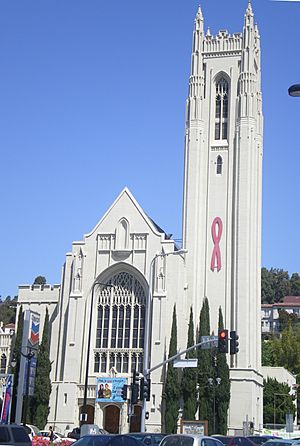Hollywood United Methodist Church facts for kids
Quick facts for kids Hollywood United Methodist Church |
|
|---|---|
| First United Methodist Church of Hollywood | |
 |
|
| 34°06′16″N 118°20′20″W / 34.10444°N 118.33889°W | |
| Location | 6817 Franklin Ave., Los Angeles, California 90028 |
| Country | United States |
| Denomination | United Methodist Church |
| Website | hollywoodumc.org |
| History | |
| Founded | March 16, 1930 |
| Administration | |
| Division | California Pacific Conference |
| Subdivision | Los Angeles District |
| Hollywood United Methodist Church | |
|---|---|
| Built | 1927 |
| Architect | Thomas P. Barber |
| Architectural style(s) | English Gothic Revival |
| Official name: First United Methodist Church of Hollywood | |
| Designated | December 4, 1981 |
| Reference no. | 248 |
The Hollywood United Methodist Church is a famous church located in Hollywood, California. It stands out with its unique English Gothic style and a large red ribbon on its bell tower. This church is not only a place of worship but also a well-known landmark. Its buildings have been used in many popular movies, like Sister Act and Back to the Future. You can find it at the corner of Franklin Avenue and Highland Avenue.
Contents
History of the Church
Early Beginnings and New Construction
The first Methodist church in Hollywood was built in 1911. It was known as the First Methodist Episcopal Church of Hollywood. This building was in the Mission Revival style. It cost about $35,000 to build back then.
However, the church could only seat 800 people. This was not enough for the growing community. So, in the late 1920s, the original church was taken down. A much larger building was planned to take its place.
Construction started in 1927 with the Recreational Hall. The rest of the church building was finished on March 16, 1930. This new, larger church is the one we see today.
A Historic Landmark in Los Angeles
In 1981, the church building was recognized as an important historical site. It became Los Angeles Historic-Cultural Monument #248. This means it is a protected building because of its history and unique design.
The Red Ribbon and Community Support
In 1993, the church put a large red ribbon on its bell tower. This was done to honor World AIDS day. The red ribbon is a symbol of support for people affected by AIDS. In 1996, these ribbons were replaced with more lasting versions. They were painted again in 2004.
Since then, the church has been a leader in supporting fairness and equality for all people. It has welcomed everyone into its community.
Church Architecture
Design and Style of the Building
The Hollywood United Methodist Church was designed by Thomas P. Barber. Its style is based on the English Gothic look, similar to Westminster Hall in London. The building is made with a strong steel frame and concrete. This design helps it to be more resistant to earthquakes.
An Italian engineer named Francesco (Ciccio) Sabato Ceraldi helped with the building's structure. The church also shows elements of American Gothic architecture. For example, its sanctuary roof has an open hammer beam design, which is a special way of building a roof without central supports.
Filming Location for Movies
Hollywood's Favorite Church for Films
Because of its great location near Hollywood movie studios, the church is often used for filming. Its mix of old Gothic and modern styles makes it perfect for many scenes.
- The famous "Enchantment Under the Sea" dance scenes in Back to the Future and Back to the Future Part II were filmed in the church's gymnasium.
- The talent show scene in That Thing You Do! also took place in the gym.
- For the movie Sister Act, parts of the church's hallways, classrooms, and offices were used. The film crew even repainted the inside to make it look older.
- Other movies filmed here include The War of the Worlds, Anger Management, Big Momma's House, and Jarhead.
The Oaks School
A School Sharing the Space
The Oaks School is a private school for students from kindergarten to sixth grade. It was started in 1985 and rents space from the church. The school is not religious and is not officially connected to the church. However, the school and church communities often work together and share some staff members.
See also
- Los Angeles Historic-Cultural Monuments in Hollywood
- Hollywood Heights, Los Angeles

